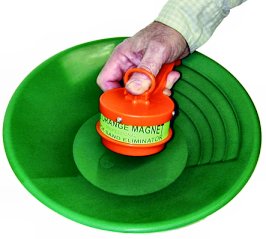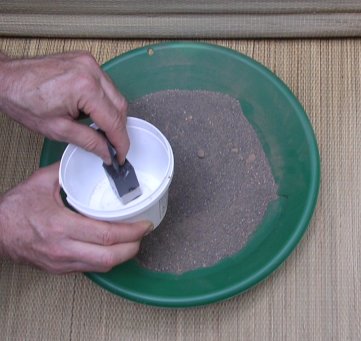|
Notes on Sources of Magnetite Black Sand for use in Experimental Magnetite Ormus Effect Water (MEOW) Treatment Devices for Treating Water and Other Liquids ver. 1.2.3 last revision date: 03/05/2020
Introduction Magnetite, also known as magnetite black sand, is a form of iron oxide. It is a very stable and dense material, and is widely found in nature across the world in a variety of natural settings as a commonplace mineral; it most commonly occurs in nature in a granular form as a sand or grit. While magnetite may sometimes occur in nature in the form in larger chunks or rocks, those chunks are almost always aggregates or conglomerates of grains held together only loosely, and these chunks, with a bit of pressure, will often crumble into granular form. Magnetite is also found as in inclusion in granite and other rocks, where it will usually be quite tightly bound in the rocky matrix; many granites in the US contain from 1% to 4% magnetite by weight. Magnetite may be found in sand form as a dense and heavy dark (at times almost black) sand on the bottoms of many streams, creeks and lakes as well as other natural bodies of water, and also in many desert sands (particularly in alluvial deposits in deserts and elsewhere), in many mountainous areas where precious metals such as gold, silver, platinum, paladium, rhodium or rubidium are found, and also in dry arroyos in the southwestern USA and in parts of Mexico and Central and South America. Magnetite is often known as magnetite black sand, or simply as "black sand". Magnetite is quite widely mined across the world, primarily for use in making iron and steel and for other uses in industry, including abrasives and cement block manufacture. Some notes follow on some possible sources of magnetite sand. A Bit More Miscellaneous Information on Magnetite Magnetite, with a formula of Fe3O4, is a very heavy, dense material, with a specific gravity of 5.18 when pure; this is 3 to 5 times more dense than most silica-rich light-colored sands, and about 5 to 6 times more dense than most soils. In fact, one of the relatively small group of things occurring in nature which are significantly more dense than magnetite sand is gold grains or granules, which exhibit a specific gravity (density) of about 19.3. The color of magnetite sand ranges from gray to dark gray or dark tan to almost black in color, although the presence of "impurities" (some of which are quite desirable when using magnetite for the purposes which we have been discussing here) may change that color a bit toward charcoal or gray-black. Magnetite is usually strongly magnetic (i.e., ferromagnetic) and exhibits high magnetic susceptibility, that is, it responds strongly to a magnet, and to use technical terms, it usually exhibits strong ferromagnetic properties, although a few forms found in nature may be more paramagnetic than ferromagnetic. Magnetite sand, when pure or nearly pure, exhibits modest electrical conductivity, although that may be hard to measure reliably in samples of magnetite sand due to the small particle size, poor electrical contact between adjacent particles, and due to the presence of "contaminant" (i.e., non-magnetite) particles which are considerably less conductive than magnetite. A Note Regarding Non-Magnetic "Impurities" in Magnetite Black Sand Intended for Use in MEOW Devices I feel that it is important to interject a brief caution here regarding use of magnetite black sand in MEOW devices such as MEOW kettles. There seems to exist in the world of MEOW devices -- and on a broader scale, the ormus and subtle energy worlds -- a firm and strong belief that MEOW devices manifest their beneficial field effect upon water due to the ferromagnetic properties of the magnetite sand, that is, that it will respond to a magnetic field quite strongly, and can even be magnetized. Concomitantly, the same people who hold to this widespread belief also seem to believe that all of the beneficial ormus effects exhibited by MEOW devices are due to ormus-like materials which are somehow dispersed or stored inside the magnetite crystalline structure. This set of beliefs almost always leads adherents to believe that high purity magnetite black sand -- that is, magnetite black sand which contains a very high percentage of magnetite and only very small percentages of non-magnetic particles of other ores and minerals -- is by far the most desirable for use in MEOW devices. And, the people who subscribe to this set of beliefs also tend to spend quite a bit of time and effort in finding high-purity magnetite sand. If they are using wild-harvested magnetite sand, they will often spend quite a bit of time and effort in performing repeated passes of magnetic separation to remove the non-magnetic particles from raw magnetite black sand in order to yield a final product which contains a very high percentage of magnetite and a very low percentage of non-magnetic particles. Based upon my observations and those of a number of other researchers of my acquaintance, I can say with confidence that while it is sometimes necessary -- dependent upon the exact properties exhibited by the non-magnetic particles -- to remove some or a vast majority of non-magnetic components from magnetite sand prior to using in a MEOW kettle, there are many cases where the non-magnetic particles, that is, the so-called "contaminants", exhibit very powerful and desirable ormus-like field effects, and in these cases, it would be unwise to remove all of the non-magnetic particles from the raw sand, as they will sometimes lend powerful and desirable effects to the MEOW device in which the magnetite black sand is to be employed. Having said the above, there are, of course, also times when it will be deemed important and even necessary to remove some or all of the non-magnetic particles from raw wild-harvested magnetite black sand, particularly in the following cases:
Let's Take a Look at Some Typical Examples of Magnetite Sand Here is a quick look at some typical examples of magnetite sand, showing the variations in particle size, color and appearance across samples. First, as we have mentioned above, most types of magnetite sand are ferromagnetic. In practical terms, this means that they will be attracted to a magnet. The image below shows a sample of magnetite sand which I call type EFLMG (which had been harvested in a desert in the Southwestern USA) clinging to a magnetic retrieval tool often used in the gold prospecting field to separate magnetite black sand from nuggets of gold. 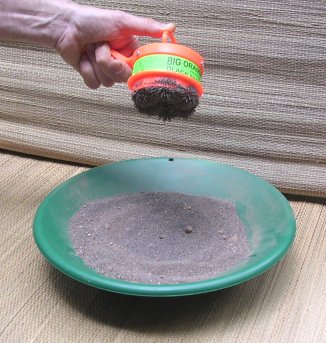 The image above shows magnetite sand clinging to a magnetic retrieval tool often used in the gold prospecting field to separate magnetite black sand from gold nuggets. The magnetite sand shown was harvested in a desert in the US Southwest; I have named this sand type EFLMG. And now, here are some close-up photos of various samples of magnetite sand. . . 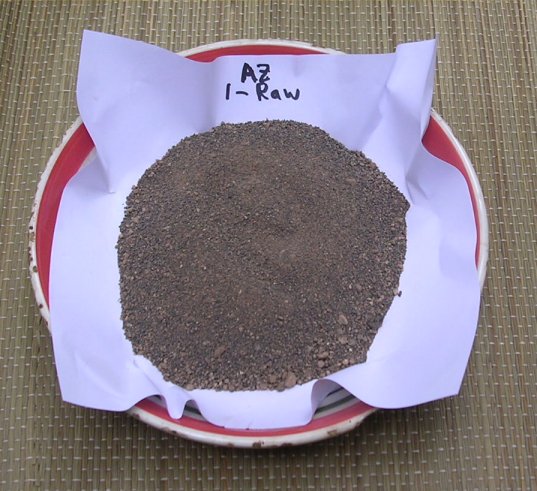 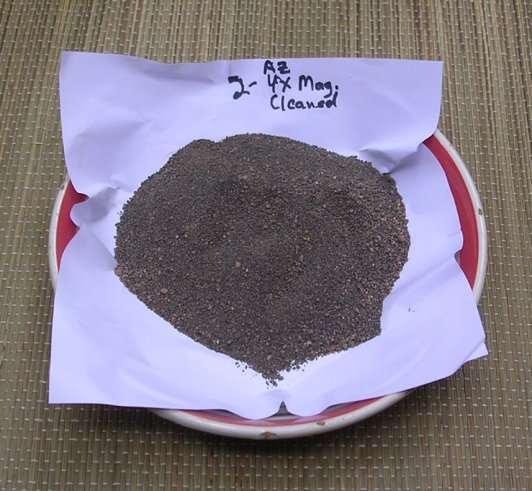 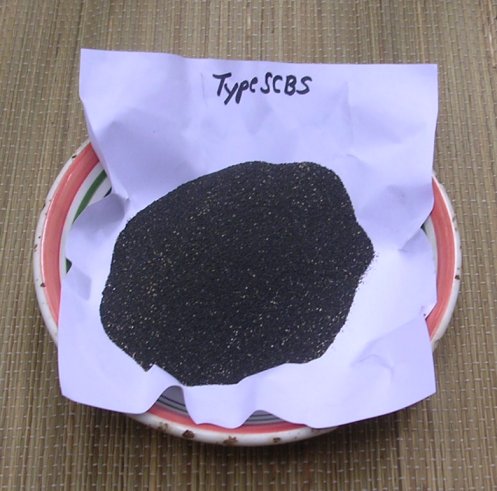 The image above shows a magnetite black sand which has been hand-harvested in arroyos of the Sandia Mountains in New Mexico by Gregg Crocco and then subjected to three stages of particulate-size screening using sieves (aka classifiers) and three stages of magnetic separation to yield a 97%+ purity magnetite sand; Gregg calls this type SCBS sand. The average particle size of the type SCBS sand shown in the image is between 20 and 80 mesh, equivalent to a medium grain size. 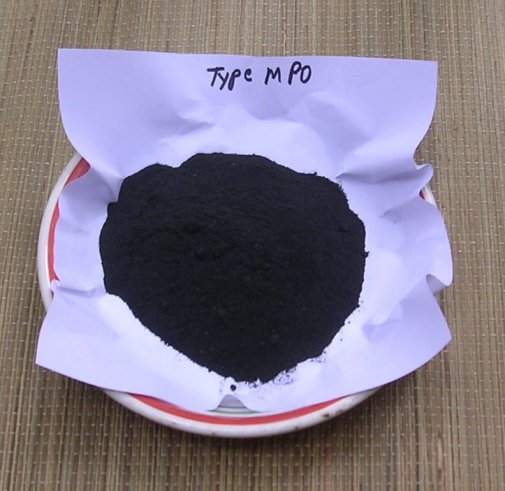 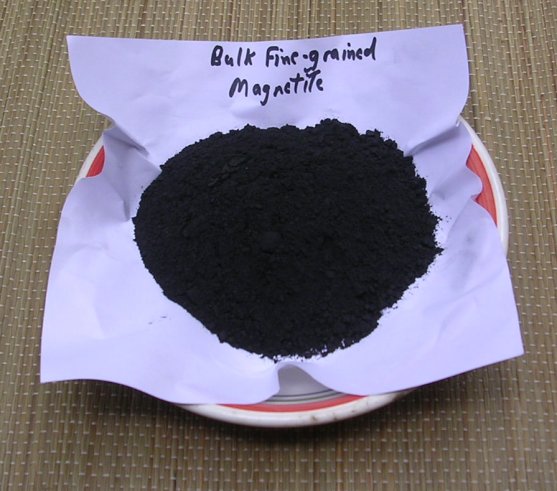 The image above shows a commerciallly-processed and milled fine-grain high-purity magnetite black sand which is used in various industries across the world. It exhibits a somewhat finer particle size than the type MPO sand shown above. I call this particular sand, which I purchase in bulk quantities for large R&D projects, type MUABF. 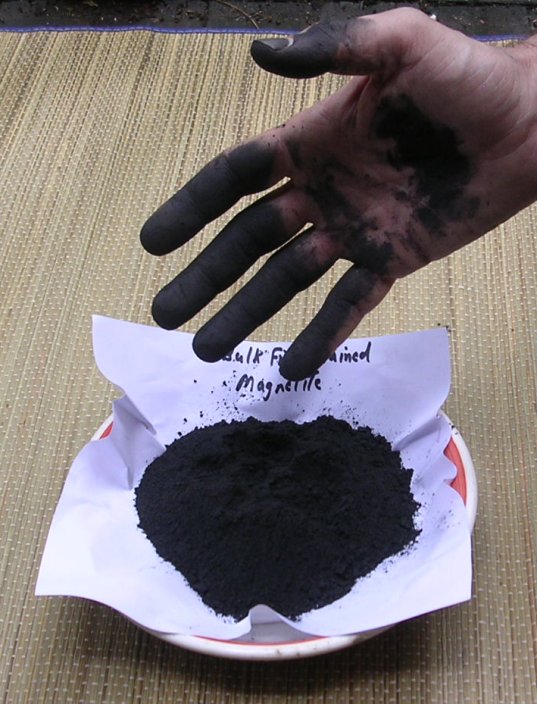 All Magnetite Sands Are Not Created Equal As noted elsewhere on this site, a number of us have found that when using magnetite sand for the purposes of constructing MEOW devices and similar technologies, not all magnetites are created equal, and rather, it seems that there is considerable variance in effectiveness or power across batches and types of magnetite sand. I strongly suspect (and a number of other researchers and observers concur) that a great part of the variance may lie in the other elements and materials found present in the magnetite, particularly the following elements and substances:
I have developed a relative 2-axis scale here in my lab for my own use for ranking magnetite sand for use in MEOW devices according to the relative power and efficiency which the magnetite seems to exhibit in treating water. Scores on the scale for samples are largely obtained not through measures from conventional Western testing equipment, and rather the scale is largely based upon my intuitive (some call it dowsing) sense of the effectiveness of the material, along with actual tests in using samples in MEOW devices, after which I assess the apparent effects of the treated water upon my body. I tend to call this rather subjective relative scale the "magnetite relative effectiveness for ormus water scale", or "MREOW scale". I may post further information about this 2-axis scale to this page at some time in the future. Magnetite Purity Please note that for our purposes, extremely pure forms of magnetite are not usually desirable (although many such high-purity magnetite sands do exhibit good "basic" MEOW effects), and rather, we will usually want magnetite which contains various desirable "impurities" such as transition elements (including the so-called precious metals), rare earth elements, and ormus forms of elements. Luckily for us, magnetite rarely occurs in nature in an extremely pure form, and even the blackest grains of magnetite found in nature, or the purified forms found in the industrial marketplace, usually contain some respectable levels of impurities (including particularly those ormus forms which I have listed above as desirable.) Which Magnetite Sand or Mixture Should I Use? As you are by now likely aware, I (and others in this field) have reported that not all magnetite sands are created equal, and also, as we have seen above, it is often the case that the highest-purity magnetite sands -- while they may still exhibit good basic MEOW effects -- are often not the most optimal sands for use in MEOW kettles, and that rather, it is often advisable to use a magnetite sand mix which includes at least some of the high-ormus non-magnetite sands which are found naturally co-occurring with magnetite sand in the wild. As a result of these facts, people often call me or write to me asking me to tell them which is the "best" magnetite sand or magnetite sand mixture (i.e., mixture of magnetite sands plus some high-ormus non-magnetite sands) for them. In one rather funny and extreme case, a healthcare practitioner wanted me to tell her the "exact best" mixture for a MEOW kettle which would yield optimal results for her and for her two hundred and sixty patients. As you likely know by now, there are many variables at play here, and they include not only the magnetite sand or magnetite sand mixture which you choose to employ, but also your setting (i.e., where the MEOW kettles will be placed), the water which you will use, and your own body and its highly unique needs and preferences. So, as you have likely guessed, due to all these variables, there is no one-size-fits-all, cut-and-dry answer which is just right for every one all of the time. Rather, it seems that different magnetite sands and mixtures will be optimal for different people, even if we were to control for all the other variables such as water type/quality and the setting in which the MEOW kettle(s) will be placed. Speaking for myself, in my home (which is located in a remote mountain wilderness area), I have about 34 MEOW kettles, all of them installed on the ground floor (it has wooden floors above a dirt floor) of my home, and among these 34 MEOW kettles, I probably employ at least 14 different combinations of magnetite sands and/or magnetite sand mixtures (most of the kettles bear labels telling me which magnetite sand or mixture is contained in the kettle) and thus I drink on a daily basis MEOW water from MEOW kettles bearing wide variety of magnetite sands. One of my personal favorites at this time is a mixture of magnetically-cleaned magnetite sand from First Opinion/Steve Fountaine, raw magnetite/high-ormus sand from the same vendor and type SCBS sand which was once sold by John Milewski. So, the bottom line here is that you are largely on your own in picking the most optimal combination for you, and I suggest that you use a combination of common sense and your intuition. For example, the two vendors of magnetite sand specifically designated for use in MEOW kettles which I list elsewhere on this page each sell magnetite sands which I feel are of very high quality, and you cannot go wrong in starting with any of their sands. As to which exact combination of their sands might be optimal for you, well, again, I cannot answer that question for you, and instead I remind you that you can use your own commonsense and intuition in picking which magnetite sands and mixtures to use for your own needs; it is your choice and there is no one right answer or right combination which is best for all. Of course, if you feel really insecure about your ability to choose, you could always hire an intuitive or clairsentient to make your choices for you, but I really doubt that it is usually necessary to go to that extreme! In the section below, we will examine some of the most common places and ways in which magnetite may be found around the world. Sources of Magnetite Black Sand Part One: Sources in Nature -- Harvesting Magnetite Sand in the Wild First, lets look at the many places in nature where magnetite sand may be found. I continue to seek and test magnetite sands from a wide variety of sources from around the world, and I continue to accrue samples, particularly from across the USA, for testing. Magnetite Sand in Streams, Creeks, Rivers and Arroyos Dense dark sands which often include high levels of magnetite sand are commonplace in many streams, creeks, rivers and arroyos (floodwater creekbeds which are dry for much of the year) across the world. Magnetite particles, due to their high mass and high density, end up collecting in the same spots in streams and arroyos (floodwater creekbeds which are dry for much of the year) and in bands (particularly near the high water level) on shores, such as those of oceans, bays and the Great Lakes. Not all dense black sands are magnetite; some dense black sands consist of ilmenite, titanomagnetite (both of which are often useful for our purposes as well, as each contains large amounts of magnetite bound to titanium), monazite, a mineral ore high in thorium, or, if the sand is rather heavy but reddish in color, hematite. The easiest way to find out how much of a black sand is magnetite is to simply run a powerful magnet near it or along the surface of the sand while it sits in a pan or bowl. Only the magnetite (and also titanomagnetite, which is gray to dark gray to dark brown in color and ilmenite, the latter of which exhibits much weaker magnetic properties because it is only paramagnetic rather than ferromagnetic) will be attracted to the magnet, while the hematite, titanohematite, monazite, tiny gemstone crystals (garnet, peridot, ruby, etc.) and any other non-magnetite components will largely be left behind; I write "largely" because it would actually take from two to five passes of magnetic separation -- depending upon the "dirtiness" of the sample -- to really eliminate at least 95% of the non-magnetite particles. Magnetite sand tends to be more abundant in areas where rock, rocky formations and sands are relatively low in silica and are dark-colored and magnetite tends to be far less plentiful in lighter-colored, silica-rich rocks and sands. If you do not live in a magnetite-rich area, the yield of magnetite sand from creek-bed or riverbed sand may be rather low in return for your efforts. In some extreme cases, in areas where lighter-colored silica-rich rocks and formations (such as marble, limestone or sandstone) predominate, your efforts may perhaps yield only a few grams per hour of magnetite sands of usable grain size, due to the low percentage of magnetite in these creekbeds, riverbeds, sands and soils. I know this from experience: I live in the Appalachian mountain range, and the granite which comprises about 20% of the local rock is about 1% magnetite by weight (in contrast to some other parts of the Appalachians, where there is a higher percentage of granite and a much higher percentage of magnetite), and so the sand in local creekbeds consists at most 0.2% magnetite, which, due to the great density of magnetite sand (about 4 to 5 times denser than lighter sands), translates to less than 0.05% magnetite sand by volume - a very tiny amount! Speaking from long experience garnered here in the mountain creeks in the region of the Appalachian Mountains in eastern U.S. where I live, I can tell you that it can be a rather slow and painful process to attempt to collect this tiny amount of magnetite from local creek sands. Even when I use extremely powerful and large neodymium magnets to try to harvest the magnetite from the sands, yields are very low and it is too painfully slow to accumulate more than one ounce per hour of magnetite sand grains of a usable size! A Few Notes on Commonly-employed Collection Procedures in This Type of Setting First, regardless of whether your venue of choice is a creek, river or arroyo, it can pay to first spend some time walking the banks or even wading in the water, to find spots where the dense black sands tend to accumulate due to their great density and weight. Such spots will often be on the outside curve of bends in a river or creek, or where water flow changes direction abruptly, or where high-velocity (aka high energy) water suddenly slows down, such as just downstream from the "bottleneck" formed in a creek or river by rocks, where the water transitions from rapid flow to a very slow and tranquil flow as it hits a much wider part of the waterway. For areas which abound in dark-colored rocks low in silica, you may be able to successfully harvest magnetite black sand in quantity from almost any sand deposits in the bed of the creek, river or arroyo. In general, when you are harvesting in the wild from waterways or arroyos, you will have a choice of either of the two following methods of collecting magnetite sand:
When panning in streams, creeks and rivers, gold prospectors across the Americas always look for black sand, as it, like gold, is very dense, and both tend to settle out of streams and rivers in the same places. Much -- but not all -- of the heavy black sand which gold prospectors collect (and ultimately discard as waste) while panning is magnetite black sand. Gold prospectors often use a variety of tools to help them in separating the dense black sands from gold, and we will be examining some of these tools later in this page, as some of them will be very useful as well for "refining" and purifying magnetite black sand. While we are on the topic of black sands found in streams frequented by gold prospectors, I have a funny story in that regard for you, as follows: There is a fair amount of gold as well as magnetite and other black sands to be found in some of the streams and rivers in Maryland and Virginia (and also, to the south, in the Carolinas and nearby states as well) and I have long been aware that many hobby gold prospectors frequent such streams (at least where access is legal), and that many of them have large pails of waste black sand sitting around their homes and garages after having repeatedly screened the material for gold particles, aka "values". So, I joined one of the local online gold forums recently, and started a thread wherein I introduced myself as a research scientist who was not interested at all in gold but rather in acquiring samples of magnetite-rich black sand from this region for testing for a non-gold-related research project (i.e., in order to allow me to test the black sand for magnetite content and trace element content and then assess the suitability of that magnetite for use in MEOW-type devices.) And so I asked in my new forum thread if folks were interested in sending me five to twenty pound bags of their waste/leftover black sand, left over from their gold panning and other separation efforts, and I offered to pay them a bit per pound for the sand and also to pay all their shipping and handling costs. Well, in short order, several forum members wrote to me off-list via private email and warned me that many gold hobbyists are very paranoid about their waste black sand, because many of them have all kinds of vague notions that there is still lots of gold present in such sands in the form of micron-sized and nano-sized particles, and these forum members warned me that my act of soliciting samples of waste black sand would probably wake up all the paranoid old-timers on the forum, who would then become very suspicious of my offer to purchase small batches of "used" or waste black sand. Sure enuf, exactly what these people predicted happened within one week, and three old-timer hobbyists tried to "confront" me, some on the forum and some via private communications, wherein they essentially stated that they did not believe that I was not interested in gold and rather, they told me that they were "sure" that I had developed some kind of super-high-tech method of extracting micron-sized and nano-sized particles and that I would become rich off their waste black sand. These allegations were followed by assertions that I would never get my hands on their waste black sand for any amount of money. These allegations were pretty hilarious, as, while it is true that all black sand from gold-bearing areas does indeed contain some gold in the form of micron-sized and nano-sized particles, any really experienced gold prospector or gold-savvy geologist can tell you that the amount of gold present in such "micro" forms in such black sand after gold panning/separation is in the order of one ounce per ten or twenty tons, and that it is largely unrecoverable; that is, it is technically recoverable, but that the methods which would be needed to ensure recovery would employ lots of toxic substances and expensive processes, and the cost of extraction would be at least ten times higher than the value of any gold (or other precious metals) recovered! In any case, after these "allegations" about the veracity of my offer and the purity of my motives were aired, a number of the gold forum members seemed to immediately withdraw from me in fear, and the three or four folks who had already offered, prior to the allegations, to sell me five or ten pounds of waste black sand all withdrew their offers. One man from the forum told me rather threateningly that he would not allow me to get rich on "all the gold" still present (i.e., as micron-sized and nano-sized particles) in the waste black sand leftover from his gold panning/separation efforts, and that rather, he planned to hoard all his waste black sand forever in buckets in his garage. By this time, I was of course, laughing my head off at the level of paranoia and defensiveness spawned by my simple and innocent request! Anyway, this experience led me to quickly conclude that there must be better ways to obtain samples of magnetite-rich black sands for my testing than via the route of asking local gold prospectors! Incidentally, while my efforts to find black sands via that particular venue in the hobby gold prospecting world did not pan out (sorry for the unintentional pun...!), I eventually befriended a nice man further down the East Coast who runs a commercial tourist-oriented gold panning operation along a gold-bearing creek which is rich in black sands, and he and I worked out a deal wherein he is willing to send me occasional five pound samples of magnetite-rich waste black sands in return for a couple of bucks per pound (for his efforts) plus S/H charges. Magnetite Black Sand Harvested from Surface Soil and Sand In regions of the planet's surface where magnetite is quite common, it is often found as a sizeable component of local soils and sands. Magnetite may be recovered in such magnetite-rich regions simply by screening soils and sands collected from the wild and then passing a magnet through the material to attract magnetite sand particles. However, much as noted above in the section covering creeks, streams and brooks, the yield may be rather low unless you live in a magnetite-rich area. Fortunately, however, magnetite is found in plentiful quantities in many spots across the US and also across the world. Many regions which contain lots of surface rocks or formations which are dark-colored and relatively low in silica are high in magnetite-rich black sands, as are many volcanic regions, including volcanic sand deposits in mountains and deserts and the flanks of volcanoes. A Few Notes on Commonly-employed Collection Procedures in This Type of Setting For most such areas, it will likely be best to collect promising-looking loose soil or sand from surface deposits in 5 gallon buckets, and then transport the buckets to your shop, home or lab, where you will subject the soil or sand to one or more stages of mechanical screening followed by one or more stages of magnetic screening/separation. However, in some high-yield areas, particularly areas rich in alluvial deposits or the sites of ancient alluvial fans or alluvial plains, collecting useful quantities of magnetite sand may be be as simple as attaching a powerful and fairly large neodymium magnet to a short piece of rope and dragging the magnet across the surface of the soil or sand, perhaps after having first loosened the top few inches with a shovel or pitchfork, stopping every minute or two to scrape or rub the magnetite sand off the magnet sand into a collection bucket. Magnetite Black Sand Found on Ocean and Lake Beaches The black sand which you will often find in bands and layers near or above the high water line (and sometimes in hollows or cavitations below the high water mark) along a number of ocean (or bay) shores and on the beaches of some lakes (including especially the Great Lakes, particularly Lake Michigan), is often primarily magnetite black sand. In the case of inland lakes, the black sands come largely from black sand eroded from rock faces and mountains over tens of thousands of years by weathering and water-mediated erosion and carried by streams into the lake itself; an even larger portion was likely created and carried by glaciers as they ground their way along the landscape in the last ice age, where they then likely dumped most of the heavier sands (such as black sand) into lakes such as the Great Lakes (which, incidentally, were formed by the glaciers in the last ice age...) Where present, this black sand, of course, can be harvested via use of the screening and magnet-separation methods described on this page; you will find more hints and details on such separation/screening methods in a later section on this page. Such magnetite black sand, if not eroded much by wave and water action, will still be angular and show crystal lines, and if heavily eroded or worn by water action, the individual grains will appear more rounded. If the black sand has already largely been separated and "condensed" by particle size and density by wave action, you will likely simply need to employ a magnet for one or two passes of final separation before you have a usable batch of magnetite black sand. A Few Notes on Commonly-employed Collection Procedures in This Type of Setting As I have mentioned in other venues, magnetite black sand collected from the beaches of lakes, bays and oceans (including the Great Lakes), much like the magnetite black sands collected from streams and creeks, should be perfectly fine for use in MEOW devices. For areas where the sand deposits are not very dark or very dense, but where some magnetite sand is present, it will likely be best to collect promising-looking loose soil or sand from surface deposits in 5 gallon buckets, and then transport the buckets to your shop, home or lab, where you will subject the soil or sand to one or more stages of mechanical screening followed by one or more stages of magnetic screening/separation. However, for high-yield deposits of rich black sand which is largely magnetite sand, you may simply choose to use a powerful magnet to collect magnetite sand, which will then be dropped into a collection bucket. You may wish to later screen the magnetite sand so collected for size to eliminate larger chunks and to retain primarily sand-sized grains, and then you may wish to do one additional pass using a magnet to exclude even more of the non-magnetite particles. As mentioned above, you will find more hints and details on such separation/screening methods in a later section on this page. Part Two: Finding Magnetite Black Sand in the Marketplace Now that we have looked at some of the most common sources of magnetite black sand in nature, lets take a quick look at some of the many ways to find magnetite sand in the marketplace. Magnetite Black Sand Available from Bulk Ore and Mineral Distributors/Suppliers There are many bulk ore and mineral distributors across the world who sell magnetite black sand in bulk quantities to industry. However, the vast majority of such suppliers, perhaps 99% of them, are set up only to handle very large-volume sales such as 20 ton to 40 ton truckloads or 50 ton to 200 ton railcar loads per batch, and where their customer provides the trucks and railcars. If your need is for very large quantities of magnetite black sand -- on the order of many large truckloads, and if your company is listed in Dunn & Bradstreet with a good rating or better (although it may sound odd to you and me, this is simply a necessary prerequisite requirement for most of these vendors before they will do business with you) and if you have the financial resources to hire a trucking firm to handle the shipping of bulk truckloads for you -- then some of these suppliers may turn out to be viable sources. However, all of these suppliers are accustomed only to selling their products in very large batches (i.e., by the truckload or by the railcar load) and they will also only sell to legitimate companies of good standing, that is, to commercial customers who have not only a real company name, address and phone number and a listing and good rating in Dunn & Bradstreet, but also an understanding of the type of magnetite sand needed and the particle size needed. Thus, unless you have a legitimate company and a need for very large quantities of magnetite black sand, along with the funds to hire a trucking company to handle shipping and a place to receive and store the sand, such bulk suppliers are likely not a workable route. Magnetite Black Sand from Magnetite Mines There are few large magnetite mines operating in the USA anymore, as much of the magnetite used here is now imported from Mexico, Central and South America, Europe and even China. However, there are still a small number of small magnetite mines in operation, and they may be found in a number of states across the USA, including New York, Pennsylvania, West Virginia, New Mexico, Arizona, Nevada, Utah and a number of other states. However, if you have not already guessed, these mines, much as is true for the ore distributors mentioned above, are invariably set up only to be able to handle large bulk sales on the order of 20 or more tons per truckload or railcar load and where their bulk customers provide all trucks (or railcars) for transportation; these mines are never set up to handle small orders such as a 50 pound bag or sack or bucket, or even a ton or two of sand. Worse, due to OSHA rules and insurance regulations, it can be a major nightmare for the mine operators to even allow a visitor onsite at the mine. Occasionally, if you know just the right person at the mine, and particularly if you have some legitimate credentials (in my case, such as being a degreed scientist and having some interests in common with the owners/operators), and if you are able to convince the mine owners or operators that your presence onsite for a very brief period of time will not be a liability to them, then you may -- on rare occasions -- be able to wrangle permission to briefly visit such an operating mine and purchase a small quantity of magnetite black sand. However, these mines never have any ability to package their sand in bags, sacks or buckets, and so, in the rare cases where you may be able to wrangle permission to purchase small quantities of sand -- perhaps on the order of 50 pounds to a half-ton -- you will need to be able to show up with your own sacks or buckets for transport, as well as a vehicle capable of carrying the containers once loaded. And you will need to be able to demonstrate that you can abide by safety rules and requirements while onsite. However, having said the above, it is my personal experience, as well as that of other researchers whom I know, that such permission is granted only very rarely. In fact, of the operating magnetite mines in the USA of which I am personally aware and where I have been in contact with the owners/operators, each has strongly requested that I never divulge the location of their mine nor their contact information to anyone, and, each of the owners/operators has made clear that our continued goodwill relationship is based upon the condition that I never reveal the mine location nor contact information for the operators, as they all feel that requests to purchase small quantities (i.e., anything smaller than the 20+ ton truckloads sold to established commercial/industrial customers who provide their own trucks for transport) would be extremely distracting and annoying; as one mine owner said to me during a conversation in late June 2007 "that would not work at all for me; I would hang up the phone on people making such a request. We are not set up for that." In light of these strong and repeated requests, please do not contact me asking for the location of any operating magnetite mines nor for contact information for the owners or operators of such mines. Such requests will not be met in a friendly or civil manner. My Magnetite Sand Harvesting Field Trips to Magnetite Mines I have, in a couple of instances, been able to procure permission from the owners of small magnetite mines to briefly visit their facilities and to collect a modest quantity (ranging from 200 pounds to 1,400 pounds) of magnetite sand (for use in my ongoing extensive R&D work in my shop and lab) in return for a modest fee, so long as I provided all containers for loading and packing the sand, along with a sturdy vehicle capable of navigating the mine site and, most importantly, capable of transporting the loaded containers. Of course, since these mines were all located many hundreds or thousands of miles from my home (and laboratory), it also fell upon me, once I left the mine site with my now-loaded buckets of magnetite, to handle all details of shipping the magnetite sand back to my home office and lab. To illustrate some of the various aspects and challenges of such an endeavor, I have created a webpage, named Magnetite Sand Harvesting Field Trip, on this site which tells the tale of such a visit which we made to a small magnetite mine in the Southwestern US in June 2007; the page includes a glimpse at the logistics of harvesting and transporting 1,250 pounds of magnetite sand from the mine site in short order, and then the logistics of subsequently packaging the sand for shipping back to my home office and lab on the East Coast, over 2,100 miles away. And, since a great number of New Agers, fringe-science researchers and alternative health researchers had advised me with utter seriousness in the months before I left for the Southwest that the deserts of Nevada, Arizona and New Mexico are home to numerous colonies of hostile alien reptoi8d reptilia9ns who are protected by renegade government agents known as the Me5n in Black (aka MIB), we also made it a point to try to meet with emissaries of the reptoi8d reptilia9ns during the field trip, and so you will find a briefing on this matter as well on the field trip report page linked above. note: due to a request received from the MIB, any and all occurrences of the terms "reptoi7d", "reptilia9n" or "me5n in Black" must appear in slightly altered form, with a numeric character inserted in the term; we were told by the MIB that this is necessary to prevent certain "interested parties" from finding these pages using an Internet search engine. Lastly, before leaving this section on magnetite mines, a reminder: In light of the many issues addressed above, please do not contact me asking for the location of any operating magnetite mines nor for contact information for the owners or operators of such mines. Such requests will not be met in a friendly or civil manner. Magnetite Black Sand Existing as Waste in Tailing Piles at Metals or Gemstone Mines It is a well-known fact that some of the massive piles of mine ore and rock waste, aka "tailings", located at many mines which exist or once existed to mine crystals, gems or ores such as copper, zinc, silver, gold or platinum group metals, may often be quite high in magnetite sand content. On the other hand, this is not always true, and some tailing piles will contain little or no magnetite sand, and others will contain lots of toxic materials that you would be wise to steer clear of. If you have found an operating or closed metals or gemstone mine which has tailing piles which contain good levels of magnetite, and you are interested in purchasing a quantity of the tailings so that you may further refine them to isolate the magnetite sand fraction, here are some hints about how you might go about that task: Operational mines: If the mine in question is still in operation, and if you know just the right people and approach the mine operators in just the right way, it may at times be possible to wrangle permission to purchase a truckload or two of tailings, but it will almost always be incumbent upon you to hire a suitable truck to transport the tailings, and you will then need a suitable spot where the tailings may be dumped and where you may then engage in the sometimes-lengthy process of separating the needed magnetite sands from the other components of the tailing sands. You will, of course, also need a place where you can permanently store or dispose of your own tailings pile of the mass of sand/gravel left over after you have finished culling the magnetite sand for your needs. Closed mines which are no longer operating: In the case of now-closed defunct mines, that is, mines which are no longer operating but where piles of tailings abound, your task may be a bit easier, as you will only need to contact the current owners of the property and gain permission to visit the site of the closed mine to pick up a truckload of tailings. In either case, it can help if you have some legitimate credentials and if you are able to convince the mine owners or operators that your presence onsite for a very brief period of time will not be a liability to them. Magnetite Black Sand, aka Magnetium or Ci Shi, from Distributors/Resellers of Oriental Herbal Remedies If you are located in or near China, the easiest way to find magnetite powder/sand easily and cheaply is to go to a distributor or reseller (vendor) of Chinese herbal medicines and remedies. One of the standard Chinese "herbal medicine" remedies is magnetium, also called Ci Shi. You will likely want to avoid the toasted form of magnetite, known as "toasted iron oxide", "toasted magnetite", "toasted magnetium" or "Duan Ci Shi", and also sometimes known as "prepared magnetite" or "prepared magnetium". One of my contacts in Hungary told me that she visited a large local distributor of Chinese remedies and asked for Ci Shi magnetite and was able to purchase it for pennies per pound from a large sack in their warehouse. Unfortunately, that cheap price for magnetium does not hold across all of Europe; other contacts located in England and France have reported to me that they paid over $6 USD per pound for magnetium from distributors of Chinese remedies in their areas. It is also possible to purchase magnetite sand as Ci Shi or magnetium from large distributors of Chinese herbal remedies in the USA and Canada, but usually you will pay from $5 to $28 per pound for such magnetite. I have tested Chinese-sourced magnetite sold as Ci Shi from two different distributors in the USA (I paid one such vendor a bit over $5 per pound and purchased a batch size of over 20 pounds), and found that it was quite interesting, but not as powerful or effective for MEOW kettle use as the type SCBS magnetite previously sold by John Milewski; the Chinese magnetite powders ranked with scores of from 55 to 67 on the first axis of my relative MREOW measuring scale while John Milewski's type SCBS magnetite (the primary and "traditional" type of magnetite which he offered) earns a score of 100 on that same scale. Steve Fountaine of First Opinion Health Discovery Center in Provo, UT offers an assortment of excellent partly-magnetically-cleaned and also raw ormus-rich magnetite-rich sands which he harvests from the ravines and arroyos in the Provo, Utah area. I have tested these sands, and they rank very well on my MREOW scale, and I can recommend them highly. Steve, via the Center, also offers pre-assembled and filled traditional cardboard MEOW kettles at a very reasonable price. Ordering Sand from First Opinion Health Discovery Center Please click here for a look at the Center's website, where they offer information on their sands and on ordering, along with photos and some testimonials from MEOW water users as well. Magnetite Chunks Available from Some Vendors of Rocks, Gems and Minerals There are a few large vendors -- both online and in brick-and-mortar shops -- of rocks, gems, crystals and minerals who may occasionally offer magnetite sand or chunks of magnetite (the chunks are usually loosely-bound aggregates or conglomerates of magnetite sand which may often quite easily broken up into sand-sized particles) for sale at prices ranging from two dollars to about fifty dollars per pound plus (hefty) shipping charges. The last time that I checked, there were only one or two online vendors offering magnetite, and at very high prices (about six dollars for four ounces) but I have occasionally, in the past, seen online mineral/gem vendors offer magnetite for prices as cheap as three dollars per pound (plus shipping). Be prepared to spend quite a bit of time doing research online or via other routes to find any of the infrequent offerings at the less-expensive prices. Magnetite Sand Occasionally Available from Online Garden or Alternative Health Product Vendors If you were to regularly perform really diligent web searches, you will occasionally (but rarely) find online gardening vendors or alternative health product vendors who offer magnetite sand as either a garden soil amendment or as a feed supplement for livestock or pets; prices will range from as little as two per pound (plus S/H) to as much as twenty dollars per pound (plus (S/H). However, it is my experience after lots of research over many months that, these offers are very few and far between, and the only two vendors of which I am aware who currently list such products have large notes on their webpages stating that they are currently out of stock on magnetite sand, and neither of the vendors answers their telephones nor returns phone messages asking if and when the magnetite sand will again perhaps be available; in fact, even email inquiries have been bouncing from both vendors for the past few months. Magnetite Black Sand Sometimes Available on Ebay You will quite often find vendors selling magnetite sand on Ebay, because there are several groups of consumer-level people who are often seeking to purchase magnetite sand, and they include not only those of us who are building MEOW kettles, but also hobbyists who wish to use magnetite for scientific experiments involving magnets, alchemists and experimenters who wish to use it as a heat source/microwave susceptor in building microwave oven kilns, and backyard experimenters who are trying to make their own thermite. When magnetite sand appears on Ebay, it is usually listed under any of the following names: magnetite, magnetite black sand or magnetite sand. Quantities will usually vary from 12 ounce bags to 15 pound boxes, and prices will vary from a low of about $1.60 per pound (i.e., a 10 pound bag offered for about $16) to a high of about $20 per pound (i.e., $15 for a 12 ounce bag.) Quality will vary quite a bit and even the definition of the term quality will vary depending upon the intended use for the sand, but in general, much of the magnetite sand offered for sale on Ebay is a very fine (from 300 mesh to 450 mesh) powdery magnetite black sand of relatively high purity usually sold for industrial purposes. When looking for magnetite sand for the purposes in which we are interested, namely MEOW research, some of these finely-powdered industrial grades of magnetite sand will be quite useful, while other batches/types will not exhibit a strong MEOW effect at all, and it can be very hard to determine and predict the usability of such a batch of industrial grade finely-powdered magnetite sand from a distance. You will also sometimes find, albeit rarely, vendors on Ebay selling hand-harvested (i.e., "wildcrafted") magnetite sand which they have collected in streams or in dry arroyos in the wild. In general, so long as a wildcrafted magnetite sand consists of at least about 79% magnetite by weight, it will usually prove to be quite useful and efficacious for constructing MEOW devices. In general, the wildcrafted hand harvested magnetite sands will be quite a bit more expensive than the industrial grades of magnetite sand, and the hand-harvested sands will usually run from $3 per pound to $13 per pound when offered on Ebay. A Response to Repeated Inquiries Asking Me if I Sell Magnetite Black Sand in Small Quantities I receive a number of inquires from folks in the worlds of MEOW devices, ormus and alchemy if I am willing and able to offer magnetite sand for sale. My answer is always as follows: With the sole exception of limited-time and conditional 24-hour offers made perhaps once or twice per year where I may offer limited amounts (perhaps two 30 pound boxes at most per person) of field-harvested magnetite black sand via a "community-supported-magnetite-sand-harvesting" (aka CSMSH) arrangement to a few friends and colleagues to help to finance one of my upcoming magnetite-harvesting field trips, I never offer magnetite black sand for sale in quantities below 600 pound batch size. Incidentally, above and beyond the small quantities distributed via the aforementioned and rare CSMSH offerings, any and all of the various batches of magnetite sands which I collect during my field trips is used solely to fuel my own research and development projects. However, for those researchers and experimenters who need bulk quantities of 600 pounds or more (and up to 600 tons) at one time of magnetite sand for use in MEOW devices and similar technologies, and who are willing and able to pay for the sand as well as the sizeable shipping and handling charges, I am able to offer magnetite sand in such bulk quantities on a prepaid basis, for delivery anywhere within continental mainland USA; the sand is available in loose bulk form via truck, or packaged in discrete 50 pound bags or discrete 30 pound boxes. Product pricing is very reasonable. Please contact me for pricing if you are interested in purchasing such bulk quantities; serious and sincere inquires only, please. Again, as noted above, I can offer for sale only bulk quantities of 600 pounds or more of magnetite sand; please do not contact me asking me to sell smaller quantities. If you need quantities smaller than 600 pounds, feel free to harvest your own sand using any of the methods described on the Magnetite Sources page on this website. Hints and Methods for Cleaning and Refining Magnetite Black Sand Much as I have repeatedly promised above, this is the section where you will hopefully find some useful hints and tips on how to separate magnetite sand from other dense black sands or other "impurities", and also some suggestions regarding possibly useful tools of the trade. First, a reminder: for our purposes, it is usually not either necessary nor desirable to clean and refine your magnetite sand using magnetic separation to a point where it is extremely "pure" (that is, containing only ferromagnetic magnetite particles, and with most or all non-magnetic particles removed), as a certain amount of so-called "impurities" are often useful for our needs, as they may often contain precisely the elements and forms of elements which seem to render MEOW devices more effective. So, the non-magnetic particulates present in raw wild-harvested magnetite black sand will sometimes contain very useful elements and exhibit very desirable and useful ormus-like field effects. For more on this topic, please be sure that you have thoroughly reviewed the information in the section above entitled A Note Regarding Non-Magnetic "Impurities" in Magnetite Black Sand Intended for Use in MEOW Devices Screens, aka Sieves and Classifiers First, lets look at wire mesh screens which are used to sort sands by particle size and to eliminate large pieces such as chunks of stones, gravel, twigs and other oversized particles. Many of these screens are made to fit the mouths of most 5 gallon buckets, and they are marketed to the hobby gold prospecting world under the names of "classifiers" or "sieves" (af few oldtimers seem to also refer to them as "clarifiers".) Without further ado, lets look at some commonly-available sieves and classifiers offered to gold prospectors which will often be eminently suited for our needs as well: Some Sieves and Classifiers Marketed for Use by Gold Prospectors: 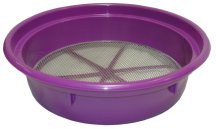 A representative image of a Jobe brand Classifier (bucket-top mechanical screening sieve) is shown above. 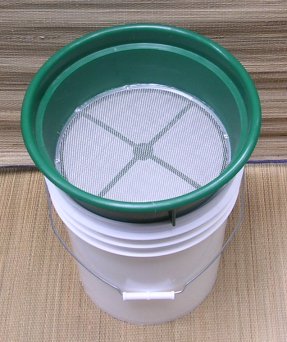 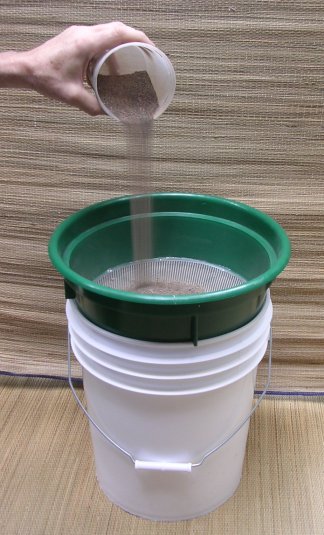 The photo above shows the classifier (sieve) in use for the purpose of removing oversized particls and stones from magnetite sand.
We will break this section into two categories, commercially-available black sand separation magnets, marketed to gold prospectors, and homemade magnetic devices, which are clumsier but which are often more powerful than their slicker commercial cousins. Let's start with the commercially-available black sand magnets. Commercial Black Sand Magnets, aka Gold Separation Magnets, Marketed to Gold Prospectors  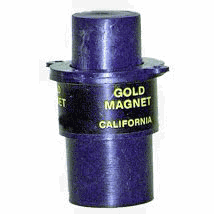 Shown
above is the Keene Engineering Gold Magnet, marketed to hobby gold
prospectors for moving moderate quantities of magnetic sand in each
"grab".
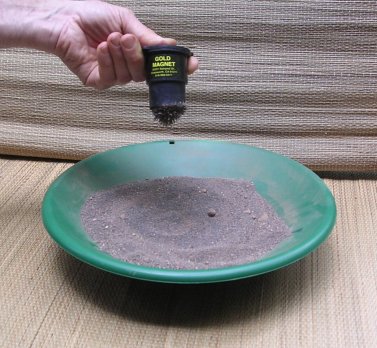 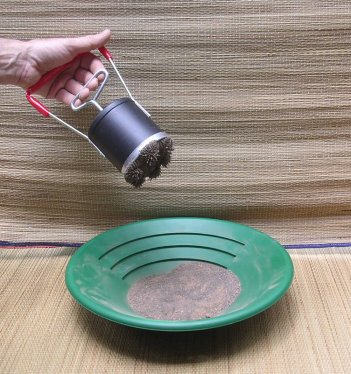 The image above shows the Bulk Black Sand Magnet in operation, retrieving magnetite black sand from a dry pile of mixed black sands in the bowl below it. The picture shows the maximum load (about 3.2 ounces, see the bulleted list below for a comparison across models) which the magnet was able to pull from a dry pile of magnetite-rich sand. Some examples follow of what seem to be the three most widely-marketed "black sand magnets":
Each of the black sand magnets listed, aka “gold magnets”, listed above are offered at the online website store of Gold Fever Prospecting. Some or all of these models may also be found at other vendors as well, including some other online vendors. Homemade Black Sand Magnetic Separation Devices
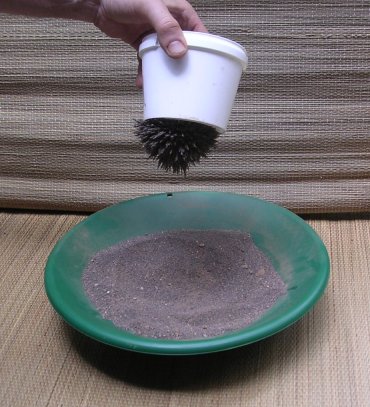 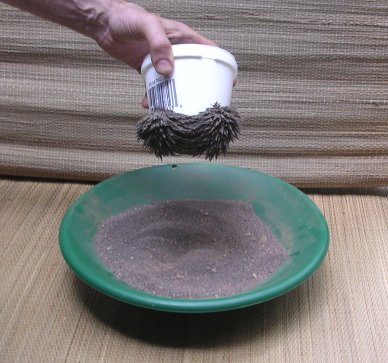 These
devices simply consist of a magnet inserted into some type of rigid
plastic sleeve to make it easier to release the magnetite sand from the
magnet at the appropriate time. Once you have placed a bare-nekkid
powerful neodymium magnet in a pile of magnetite sand and then
subsequently attempted to get the sand off the magnet, you will see why
the rigid external plastic sleeve is so useful! Further Notes and Q/A on Constructing Your Own Devices Please see the FAQ page elsewhere on this site for further notes and questions and answers regarding constructing your own devices using cardboard and hot glue. Supplemental Mixture for the Magnetite Sand If you wish to read more information on the supplemental amendment mixture which I have developed which seems to potentize the ormus-creation effects of the magnetite black sand, please visit the main page of this website or the Prototype Products Catalog page. Requests for Bottles of Treated Water and for PoP Prototype Devices Assembled Using Sturdy Plastic Shells If you are looking for MEOW treated water or for pre-assembled devices and shells for devices (where you procure magnetite from a source of your choice and fill the device with magnetite after receiving the shell), please see the Prototype Products Catalog page on this website.
Disclaimer Any products, technologies or devices mentioned on this page are experimental prototypes only, produced for the sole purposes of research and Proof of Principle (PoP) evaluation by professional or individual researchers or experimenters. The reader understands that the author is not engaged in rendering health or medical advice or services. The site owner and authors provide this information, and the reader accepts it, with the understanding that people act on it at their own risk and with full knowledge that they should consult with licensed primary care medical professionals for any medical assistance they may need. The author(s) of the material presented on this site are neither medical nor nutritional professionals. If you wish to learn more about my work and/or about my consulting services, please feel free to visit my main website at www.vinnypinto.us Webpage
creation and editing notes: The webmaster, web designer and webpage
editor for this website is Susan Hislop (aka Sue-Cat). You may visit
her website on knitting technical editing at http://www.sue-cat.com/
|
